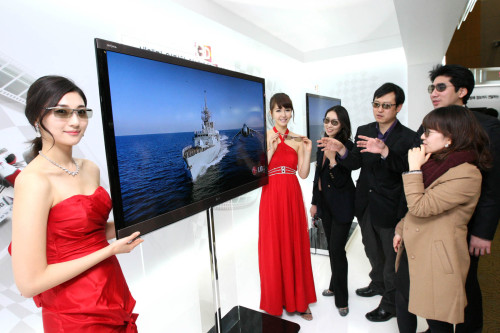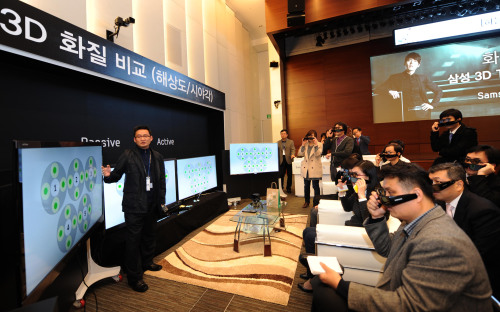Samsung emphasizes smarter online features, LG claims brighter, clearer picture
Korea’s electronics powerhouses, Samsung and LG, are embroiled in a bitter war of words trumpeting the superiority of their 3-D TV technologies.
The two top TV makers are pinning high hopes on the next-generation moving picture which promises to create lucrative revenue sources.
The battle is becoming increasingly intense as the two players strive to pre-emptively lead the burgeoning market by having their technology as the prevailing global standard.
While downplaying each other’s manufacturing recipe, they are aggressively laying out marketing campaigns targeting customers and the media for their new lineup of full high-definition 3-D TVs.
On Feb. 16, LG unveiled new products embracing film-type patterned retarder technology, which it claimed provide brighter and clearer vision without generating flicker and cross-talk ― image ghosting ― as users have complained about existing ones.
“FPR will ultimately become the next generation of 3-D technology,” said Kwon Hee-won, executive vice president of LG’s home entertainment unit, adding that up to 80 percent of all LG 3-D TVs would adopt the method.
LG also introduced new lightweight glasses that it said reduce eye fatigue and enable flexible head and body movement such as lying down on a sofa without losing 3-D images, unlike previous versions.
Korea’s electronics powerhouses, Samsung and LG, are embroiled in a bitter war of words trumpeting the superiority of their 3-D TV technologies.
The two top TV makers are pinning high hopes on the next-generation moving picture which promises to create lucrative revenue sources.
The battle is becoming increasingly intense as the two players strive to pre-emptively lead the burgeoning market by having their technology as the prevailing global standard.
While downplaying each other’s manufacturing recipe, they are aggressively laying out marketing campaigns targeting customers and the media for their new lineup of full high-definition 3-D TVs.
On Feb. 16, LG unveiled new products embracing film-type patterned retarder technology, which it claimed provide brighter and clearer vision without generating flicker and cross-talk ― image ghosting ― as users have complained about existing ones.
“FPR will ultimately become the next generation of 3-D technology,” said Kwon Hee-won, executive vice president of LG’s home entertainment unit, adding that up to 80 percent of all LG 3-D TVs would adopt the method.
LG also introduced new lightweight glasses that it said reduce eye fatigue and enable flexible head and body movement such as lying down on a sofa without losing 3-D images, unlike previous versions.

Customers can enjoy 3-D viewing even without glasses, LG noted, whereas Samsung’s products require them to sit directly in front of the TV, wearing clunky, battery-charged eyewear.
“We’ve focused on human factors to make sure that our products give customers an easier and more convenient viewing experience,” Ro Seog-ho, senior vice president of the unit, told reporters.
Samsung was quick to take the bull by the horns, downplaying LG’s efforts the following day at a showcase for its latest 3-D smart TVs that provide better access to online portals and social networking services.

“The FPR technology was developed in 1935 and nothing has changed since then,” said Yoon Boo-keun, president of Samsung visual display business. “Not as many players in the global market including those in Japan are using the passive method, acknowledging picture quality problems that would occur on large screens.”
The FPR system uses polarized glasses to view stereoscopic pictures with visual information sent both to the left and right eyes simultaneously. It also saves manufacturing costs, experts say, by attaching special films on the surface of the panel to create the illusions of a three dimensional image.
The shutter glass approach, in contrast, creates a sense of depth by sending visual information to each eye in sequence but requires expensive liquid crystal glasses.
Samsung is pushing the mechanism alongside other competitors like Sony and Panasonic while LG is joining forces with Toshiba, Philips and Vizio of Taiwan to boost the FPR technology.
Not only is LG’s method outdated, but it cannot render full HD on a large screen, Yoon said.
“FPR would give some advantages in cost but that’s all. FPR can’t realize full HD images as it has technological drawbacks, limiting its use to small-sized mobile gadgets,” he said.
The latest lineup would show substantial improvements in diminishing the flicker and cross-talk, he noted.
In efforts to conclude a winner, Kwon Young-soo, chief executive of LG Display that supplies panels to LG Electronics, suggested a demonstration to compare specifications of the 3-D TVs.
Refuting Samsung’s claim on full HD picture quality, he said it is “not even a subject for discussion.”
“This is stirring up confusion,” Kwon told reporters last week in a meeting. “I will try to arrange a demo event or press conference as soon as possible.”
Samsung’s Yoon soon reportedly responded that he would accept it “if an accredited institution participates in the event.”
But even before settling on a date, Kim Hyun-suk, vice president of Samsung’s digital media business, shot back with severe criticism against LG at a press forum held Tuesday at the company’s Seoul headquarters.
“LG is making a big deal out of such a ridiculous thing,” he said. “This is an unacceptable situation ― it is saying yes when everyone else in the world says no.”
The event came as part of the firm’s “Tuesday Forum,” a weekly meeting in which Samsung senior officials introduce and analyze its new technologies to journalists.
But it was more intended to condemn LG’s strategy, attendees said, rather than focusing on showcasing Samsung’s own technology.
“In the past, LG criticized the technology used to transform 2-D vision to 3-D, then adopted it using Taiwanese components,” Kim said. “LG does things with words first when it doesn’t have technology and later changes its attitude.”
Kim said he found no document that shows the passive FPR method can embrace full HD images.
Citing a report by an LG-affiliated think tank, he said the FPR reduces the resolution of image to half, and 3-D TV without glasses cannot be commercialized.
“I heard that LG Display’s Kwon said its TVs are full HD, I think his engineers are really stupid,” he went on. “It’s a lame argument with no theoretical ground. It’s just unreasonable.”
Critics say the technology debate is becoming ugly as it heated up so much that it turned into a bickering between the executives.
“Competition is inevitable when rivals come up with new products, but this time it reached an excessive degree,” an industry official said.
“It doesn’t look really good that they are so eager to scratch each other’s products instead of promoting their own.”
Samsung’s Kim added he wanted to “put an end to the 3-D argument” and hoped that the two companies would move on.
But it is uncertain whether they can, as LG Electronics issued a statement Wednesday to defend its corner.
It stressed that its FPR panels evolved from the old polarizing method and that companies like Panasonic and Mitsubishi upheld its full HD picture quality.
“(Samsung) merely denounces our technology based on archaic and general understanding, without having core knowledge,” the statement said.
The firm jostled to arrange a conference for Thursday. Kwon will try to wipe out “the confusion” on 3-D technology, it said.
By Shin Hyon-hee (heeshin@heraldcorp.com)
<관련 기사>
LG전자도 10일 비교시연회 준비
삼성전자와 LG전자의 신제품 3D TV 신경전이 본격적인 홍보 싸움으로 번지고 있다.
일부에서는 자사 제품 홍보보다 타사 상품 헐뜯기에 열중하는 모습이 지나쳐, 눈살을 찌푸리게 한다는 지적도 나온다.
삼성전자는 8일 서초사옥에서 출입 기자들을 대상으로 3D TV 설명회를 개최한다.
신제품에 대한 이해를 돕기 위해 통상적으로 마련해 온 '화요포럼'의 형식을 빌렸지만, 사실상 셔터안경 방식의 문제점을 지적하며 '맞짱대결'을 걸어온 LG전자에 대한 견제 성격이 강하다.
필름패턴 편광안경(FPR) 방식 시네마 3D TV를 출시한 이후 LG전자에서 사사건건 삼성의 셔터안경 방식의 어지럼증 문제 등을 지적해 온 만큼, 이참에 언론을 통해 자사 기술을 정확히 알려 논란을 종식시키겠다는 의도인 셈이다.
행사에는 영상디스플레이사업부 개발팀 김현석 전무가 참석, '삼성전자 3D TV 핵심기술'을 주제로 자세한 설명을 벌일 예정이다.
LG측도 오는 9일 여의도 트윈타워에서 별도 설명회를 준비 중이다.
특히 이날 행사에선 삼성전자와 LG전자의 신제품 3D TV에 대한 비교 시연을 진행한다.
'맞짱대결'을 제안했던 권영수 LG디스플레이 사장이 직접 나서 3D 기술에 대한 상세한 설명도 진행할 계획이다.
LG디스플레이 관계자는 "3D TV 기술이 계속 논란이 돼 온 만큼, 이번에 확실한 비교 시연을 통해 어느 회사 제품이 친인간적이고 화질이 좋은지 따져보자는 것"이라며 "매장에서 판매하는 제품을 그대로 들고 와 어떤 조작도 하지 않고 바로 비교하는 자리기 때문에 정확한 비교가 가능할 것"이라고 말했다.
일부에서는 양사의 경쟁이 지나쳐 이전투구 양상이 되며 볼썽사납다는 비판도 나온다.
한 관계자는 "신제품이 나오면 시장 경쟁이야 어느 정도 불가피한 일이지만, 이번에는 도를 넘어선 것 같다"며 "자사 제품을 광고하기보다, 타사 제품 흠집내기에 열올리는 모습이 좋아보이지는 않는다"고 지적했다.
(연합뉴스)







![[Graphic News] More Koreans say they plan long-distance trips this year](http://res.heraldm.com/phpwas/restmb_idxmake.php?idx=644&simg=/content/image/2024/04/17/20240417050828_0.gif&u=)
![[KH Explains] Hyundai's full hybrid edge to pay off amid slow transition to pure EVs](http://res.heraldm.com/phpwas/restmb_idxmake.php?idx=644&simg=/content/image/2024/04/18/20240418050645_0.jpg&u=20240419100350)





![[From the Scene] Monks, Buddhists hail return of remains of Buddhas](http://res.heraldm.com/phpwas/restmb_idxmake.php?idx=652&simg=/content/image/2024/04/19/20240419050617_0.jpg&u=20240419175937)

![[KH Explains] Hyundai's full hybrid edge to pay off amid slow transition to pure EVs](http://res.heraldm.com/phpwas/restmb_idxmake.php?idx=652&simg=/content/image/2024/04/18/20240418050645_0.jpg&u=20240419100350)

![[Today’s K-pop] Illit drops debut single remix](http://res.heraldm.com/phpwas/restmb_idxmake.php?idx=642&simg=/content/image/2024/04/19/20240419050612_0.jpg&u=)